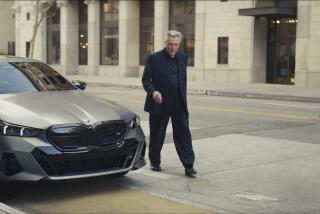The Clios: Masterpieces in the Art of Selling
- Share via
Sometimes a TV commercial will pass into the vernacular (remember “Where’s the beef?”?), but most of the time its appearance is a swift cue for us to do something--anything--other than watch television. The Clios--the awards that honor the best commercials each year--were concocted nearly 30 years ago to prove that there is indeed an aesthetic to all things, and to give heart to those people who work in the dubious profession of butting in.
The 1989 awards were announced in New York over the summer, but the public will get to see the winners in a screening at 8 tonight at the Wilshire Ebell. Since they were culled from nearly 27,000 entries, you could expect that virtually all these ads have something to recommend them, whether it’s humor, pizazz, beauty, spectacle, or a surprisingly effective and even profound social concern. The worst you could say about any of them is that they’re short.
Taking this batch as a representative sample, tots and pets appear to rank highest as ideal pitchmen--who could resent them for being too cute? There’s less sex here than you’d expect from an industry that uses hunks and bathing beauties to shill almost anything, though in a couple of instances a sexual theme serves an inadvertently cynical end, as when that soignee Revlon model brushes aside every male-on-the-make cliche to tell us: “Never take men like this seriously, but by all means take them”; or when that young stud in Levis virtually abducts a willing teen-age girl from under the nose of her fuming father, who’s left stranded in the desert. Thanks, guy.
There is, however, a funny Seagram’s Wine Cooler ad in which a young woman runs a whole love-and-marriage fantasy through her mind over the sight of an unassuming stranger at the other end of a bar, and then berates him when the marriage sours (he, of course, has no idea what she’s indignant about, or what’s behind her lament: “Relationships are so complicated”).
And you have to feel for the exquisite anguish of that hotel room-service waiter who delivers breakfast to two lissome women dressed only in bras and panties: Gazing discreetly down as he uncovers their tray, his eyes fall painfully on the sight of two hard-boiled eggs. The ad, for bras, was made in France. The French haven’t lost their touch.
Though humor is the device used most frequently to get a point across, the strength of a number of these ads is in how gorgeous they are to look at, whether in the deliquescent way the camera caresses the contours and surfaces of a BMW, or in how darkly lush and shimmering Ireland looks in a tourist ad--you can almost smell the fecundity of its landscapes as they softly unfold before the eye. Whitney Huston has just the right buoyancy and vocal panache to offset the elaborate techno-pop atmosphere of her Diet Coke spots. And the angelic purity of those boys’ choral voices in Kodak’s “True Colors” ad is every bit as touching now as they were when we first heard them during the Seoul Olympics.
Even while we can appreciate the dexterity, technical assurance and innovativeness of a lot of these ads, it’s a little grim to realize to what degree we’re forever being caught up in these swift rites of manipulation, and how inescapable and ubiquitous is the sales pitch in the modern world. To sit through a program dedicated purely to commercials is to feel a perverse satisfaction: This is what television is about; this is what television does best. These ads are a kind of TV haiku where the medium is indeed the message and the message is always about sales.
There is the occasional startling exception, here expressed in the public service ad. A Marlboro-Man type out on the range lights up a cigarette and doubles over in a coughing jag; the sardonic narrative says, “No wonder the cowboy is a dying breed.” In a Third World Charity spot, a towheaded British lad descends into a public lavatory and drinks out of a filthy toilet bowl. The narrator intones, “Five million children die in the Third World from drinking water polluted with feces. . . . If you don’t mind little black children drinking out of a toilet, you won’t mind little white children drinking out of a toilet either. Or is there a difference?”
The subtlety and visceral power of this ad shows us that we can question the aims of some if not most commercials, but not their power to coerce.
The Wilshire Ebell is at 4401 W. 8th Street in Los Angeles. Information: (213) 656-8751.
More to Read
The biggest entertainment stories
Get our big stories about Hollywood, film, television, music, arts, culture and more right in your inbox as soon as they publish.
You may occasionally receive promotional content from the Los Angeles Times.










